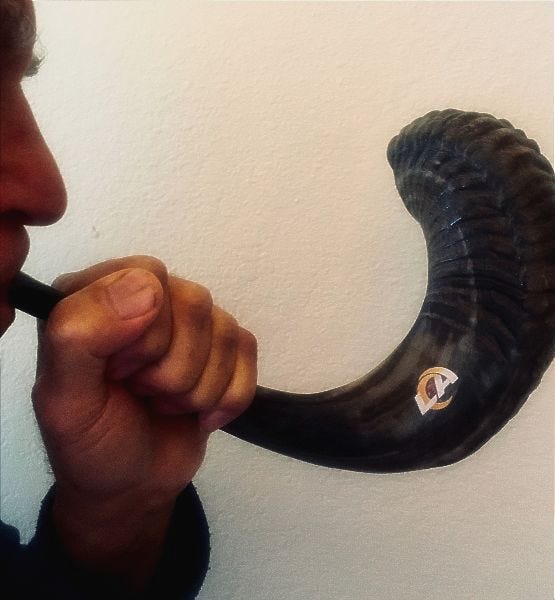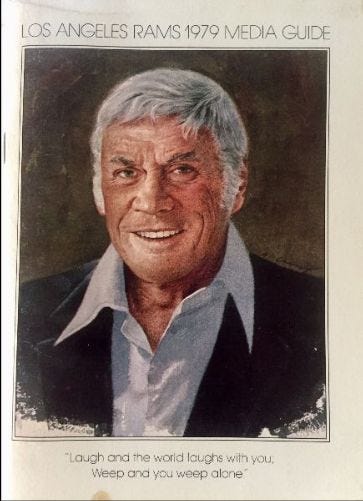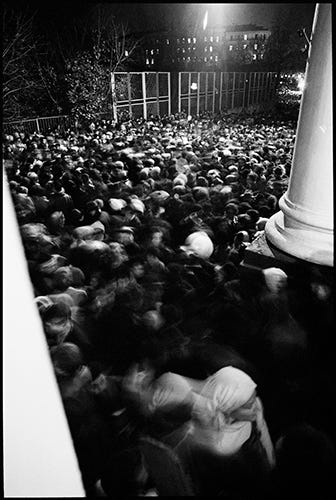Super Bowl Shabbat
February 11, 2022
A New Scroll of LA Jewish News
Folks,
The name and logo of the LA Rams holds a special call to Jewish fans. With that horn-ish connection in mind, this issue takes a look at some of the team’s Jewish history as well as a Jewish connection to Inglewood. A couple of LA synagogues, Temple Adat Shalom and Adat Ari El, must sense that Jewish bond to Sunday also, as each is calling this weekend’s day of rest "Super Bowl Shabbat." So, Super Bowl Shabbat it is. During the game, regardless of who wins, just stay light on the pita chips and Bamba, and you will be fine.
Especially if you are in a celebratory mood, do not forget to cheer for MegilLA! Please become a Team Player (or whatever sports cliché works for you), and subscribe today.
Shabbat shalom
Edmon J. Rodman
////\/\\\\
////\/\\\\
How an Inglewood raid hurt the KKK
W. S. Coburn, Ku Klux Klan Grand Goblin for the Pacific Coast, 1921.
Edmon J. Rodman
As Inglewood prepares to host Super Bowl LVI, a game that will display the athletic talent and skills of many Black NFL players, it can be recalled with a trophy of irony, that almost one hundred years ago, the city was a bastion of white supremacy in LA County, and the site of an infamous Klu Klux Klan raid.
The story of the Inglewood raid, was recounted recently in an article in the online Essential California newsletter. Adding to the story, MegilLA has found an intriguing Jewish connection to the horrendous event.
On the evening of April 22, 1922 around 100 KKK members converged on the Inglewood home of Fidel and Angela Elduayer, Basque immigrants from Spain. Members of the mob later claimed that Elduayer family were bootleggers who had made “rotten booze.” That night several masked Klan members entered the house and beat up Fidel and his brother Mathias, while others stood watch in the front yard.
The Elduayer's daughters, Bernarda, 13, and Mary, 15, who had been in bed sleeping, according to statements given later, were awakened by the raiders, and forced to dress in their presence. They were able to escape along with their mother.
Fidel and Mathias, were tied up and taken out of the house and some of the Klansmen drove them away.
The Inglewood police were tipped by a neighbor, and when they arrived shots were fired, and a Klan raider killed. The following day, the LA papers were full of the frightening story.
During the prosecution of the raid, around 150 SoCal residents were exposed, including some in law enforcement, as members of the KKK.
The search for evidence also led to a downtown LA office building, which was owned by the heirs of a well-known Jewish businessman and philanthropist Abraham Haas.
Statements taken by authorities and evidence found after the raid led the police to the office of William S. Coburn, who was the Grand Goblin, of the Pacific Coast Domain of the Ku Klux Klan. A search warrant was served on his fifth-floor office in the Haas building in the downtown business district at the corner of Broadway and 7th.
According to a 1922 story in the Los Angeles Herald, the office “was found to be filled with "two carloads" of literature and equipment pertaining to the Ku Klux Klan, which sometimes referred to itself as the “Invisible Empire.” Found were membership applications, and “scores of checks.” Klan regalia was also found: white robes with hoods, some of it marked with names.
How does the LA Klan office find its way to the Haas building?
Abraham Haas was born in Bavaria in 1847. He came to LA around 1864 at age 17, and by 1867 founded a wholesale food business which eventually became Haas, Baruch & Company, a highly successful company that in the 1950s merged with Smart & Final.
Abraham Haas, photo, California Historical Society
In 1901, Haas moved to San Francisco, and ran his growing business empire from there. In 1915, he had the Haas building constructed, and by 1921 it was occupied with respectable tenants like the Bank of Italy on the ground floor, and Dr. Henry M. Silverberg, who practiced dentistry on the 7th.
During his lifetime, Haas was known for his philanthropy to Jewish organizations. In April of 1921, he died, leaving his business, and philanthropic interests for his family to carry on.
When questioned by the LA Times about how Coburn had been allowed to rent an office, building officials, who were reluctant to respond gave a succinct explanation. “Coburn represented himself as an attorney-at-law when he first came here and we were under the impression that the office would be used for the purposes of law practice,” they responded. “We feel confident the office will be vacated,” which it soon was.
As a result of the public outrage, and the evidence gathered in Coburn’s office, LA District Attorney Thomas Lee Woolwine declared in the LA Herald: The “Invisible Empire is made conspicuously visible.”
The men indicted for kidnapping the Elduayer brothers were eventually acquitted, however, a devastating light had exposed the local Klan leadership, operations, and its members.
Though there was an active KKK chapter in the South Bay until the early 1930s, the publicity and outcry around the raid marked the beginning of the end for the KKK in Southern California.
////\/\\\\
Carroll put a 'bloom' on the Rams
Edmon J. Rodman
Will a ram’s horn be blowing in victory this Sunday? If it does, that joyous tekiah will have roots in a football deal made fifty years ago.
Early in the 70s, a Jewish owner, Carroll Rosenbloom, took over the Rams. Previously, Rosenbloom had been the owner of the Baltimore Colts — winners of two NFL titles and a Super Bowl under his control — when he traded his franchise for the Rams in 1972. The team played at the Coliseum, but Jewish fans and passersby could hardly miss the team’s offices located at 10271 W. Pico Boulevard, close to Hillcrest Country Club and Temple Isaiah.
Born in Baltimore in 1907 to Anna and Solomon Rosenbloom, Carroll Rosenbloom was the eighth of nine children. His father, an immigrant from Russia, founded a successful work-clothing manufacturing company. After his father’s death in 1942, Rosenbloom sold the business, which had grown substantially, and used the proceeds to invest in other enterprises, including the Baltimore Colts in 1953.
In 1973, Rosenbloom was able to sign a Jewish player, Bob Stein. He played two seasons as linebacker for the Rams during a six-year career that also included stops in Kansas City, Minnesota and San Diego. Stein was inducted into the National Jewish Sports Hall of Fame and Museum in Commack, N.Y., in 2005.
The Rams owner was “a hard-driving businessman,” John Eisenberg wrote in the column, “Carroll Rosenbloom: Man of Mystery,” which appeared on Pressbox, a sports website. In the piece, Gene Klein, late owner of the San Diego Chargers, is quoted as writing “Carroll was one complex individual. Very smart, very tough, often very nasty. He always gave you the feeling that, if you crossed him, he was capable of slitting your throat, then donating your blood to the Red Cross blood drive.” Rosenbloom was also known to help his players set up businesses.
Although Rosenbloom once told a United Press International reporter, “I make no claim to be a religious man,” his feelings about Jewish observance were tossed into the middle of a scheduling dispute with the league in 1976. It happened when a Rams away game with the Miami Dolphins was scheduled for 4 p.m. on Erev Yom Kippur. Rosenbloom felt the timing would cause Jewish fans to leave at halftime so they could go to synagogue, UPI reported. “This is a thing that was done with malice aforethought,” he said. Rosenbloom lost his argument, and the game went on as scheduled.
Tragically, Rosenbloom drowned in 1979 in Florida while swimming in the ocean. He was 72. The team’s 1979 Rams media guide remembered Rosenbloom as a man who “loved football and the persons connected with it.” When he died, “there were no dry eyes at the Rams office on Pico Boulevard,” it said.
In 1980, his widow, Georgia Frontiere, with whom he had two children, moved the team to Anaheim, and eventually St. Louis. Two years after Frontiere’s death in 2008, her children sold the team to current owner Stan Kroenke. In 2016, Kroenke returned the Rams to LA, and a chance for Super Bowl glory in their own stadium.
////\/\\\\
Bill Aron, Simchat Torah Archipova St. Moscow, 1981, Soviet Union.
Not interested in football?
Then, this Sunday plan a super visit to The Wende Museum where you can take in “Soviet Jewish Life: Bill Aron and Yevgeniy Fiks.” During travels to Leningrad, Moscow, and Minsk in 1981, Los Angeles photographer Bill Aron photographed ritual and social moments in various synagogues and captured the angst of Refuseniks, Jews who wished to emigrate but were denied permission. Artist Yevgeniy Fiks left his native Moscow for New York in 1994, at the age of 22, began to create several multimedia projects that reexamine Soviet history. Even if you are watching the Big Game, during halftime you can virtually visit the show HERE.
////\/\\\\
LA Jewish history tour is ready for its close-up
Providing a bright backdrop for the coming awards season, the historic neon lights of LA’s Broadway glow with the little-known story of the city’s Jewish history. Many of street’s 12 movie theaters, debuted films that changed motion picture history, like the Tower Theater's screening of the ground-breaking talkie, the "Jazz Singer."
Demonstrating that Jews contributed to the early days of the film business in unexpected ways, many of the street's movie palaces were designed by Jewish architects like G. Albert Lansburgh, or conceived by Jewish showmen, like Sid Grauman.
Other historic buildings found on Broadway were the homes of Jewish-owned department stores, men’s and women’s clothing shops, jewelry stores, food markets, and cigar stands.
Over the last year, I have been collecting artifacts of Broadway’s past, researching and walking the street, getting a feel for the Jewish life that once flourished there. To share that work with you, I will be leading a walking tour of the street called “Jewish Lights Over Broadway" on Sunday, March 27 from 7 to 9 p.m.
The tour, organized with the Museum of Neon Art in Glendale, the tour (RESERVATIONS REQUIRED, make them HERE) illuminates how the Jewish entrepreneurs of Broadway, many of them immigrants, filled the street with bright lights, and the city’s homes with music, the latest in fashion, and the staples required to satisfy a hungry, growing city.
////\/\\\\
Seen On the Way: Inglewood
For a moment in the early 1960s, Inglewood was a place for interfaith cooperation between Jews and Christians. Beginning in 1961, Temple Beth Ohr of Inglewood held weekly and High Holy Day services at the Morningside Community Church at 8722 Crenshaw (pictured above). Also in ’61, the Reform temple, which the B’nai B’rith Messenger called “the first Jewish congregation in Inglewood," hired their first full-time spiritual leader, Rabbi Arthur J. Abrams, who was ordained at the Hebrew Union College-Jewish Institute of Religion in Cincinnati. Beth Ohr’s stay at Morningside lasted only a year. The synagogue which saw itself as a spiritual home for Jews living in Gardena, Torrance, Hawthorne, and Southwest Los Angeles, moved in 1962 to its own building at 3818 W. Imperial Highway in Inglewood. By 1965, though, Beth Ohr merged with Temple Israel, and moved to their location in Westchester, becoming Temple Jeremiah.
////\/\\\\











